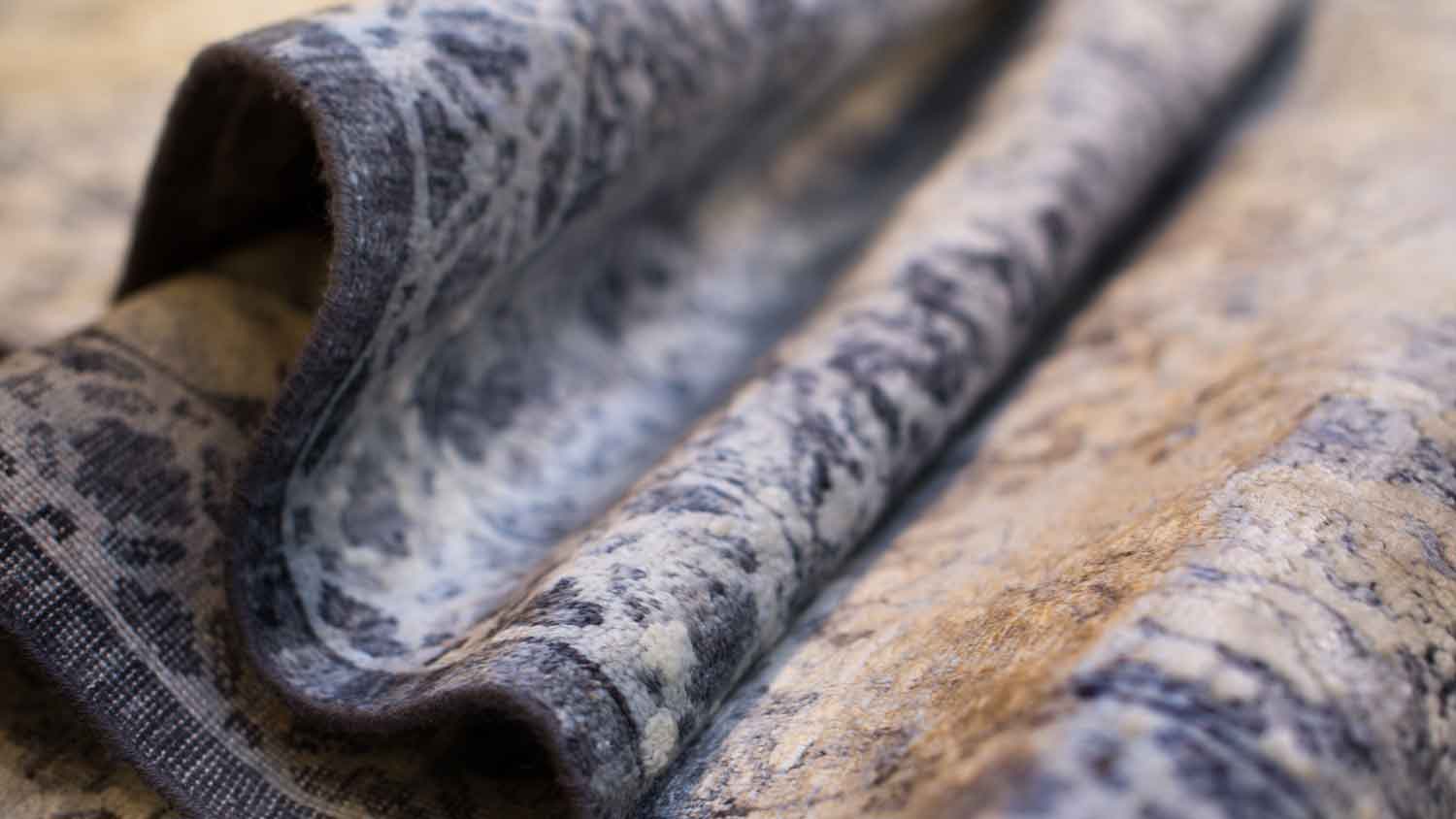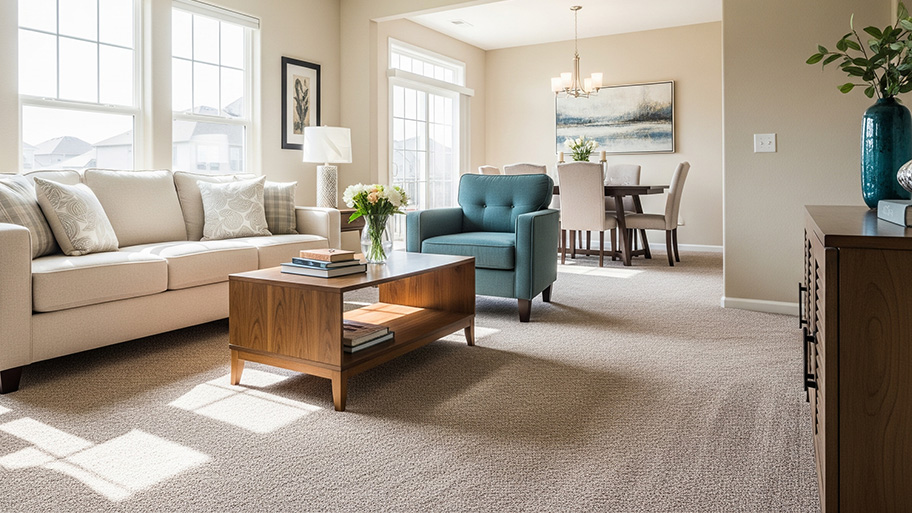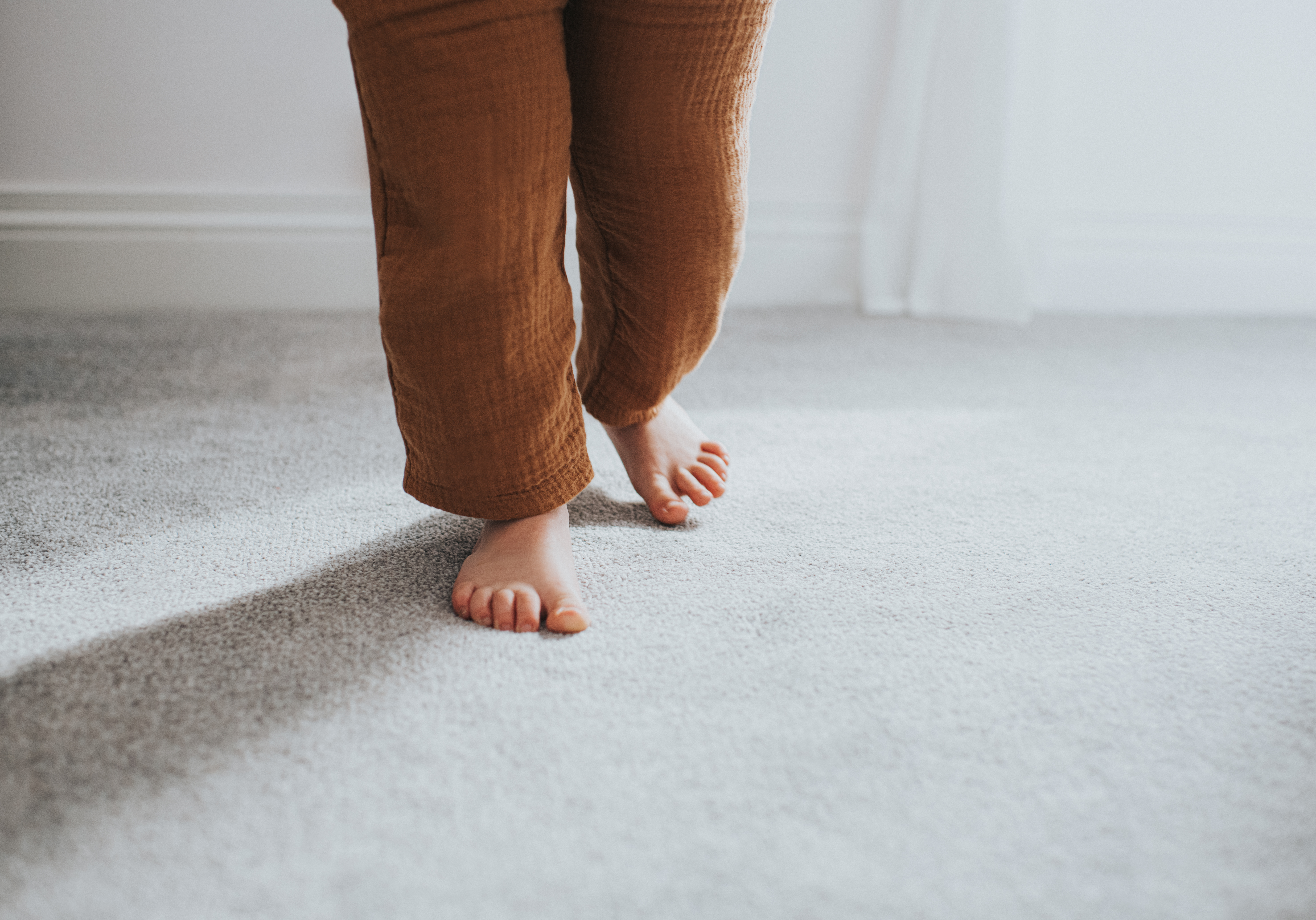
Carpet padding makes your carpet feel extra comfortable and protects your floors from damage, but how much does carpet padding cost? Let’s look at the numbers.
Find the magic carpet type to transform your space


Hire a local carpet installer to help you select the right carpet, taking into account your budget, fiber preferences, and the level of traffic your space gets.
Pile height plays a significant role in carpet selection—shorter piles are better suited for high-traffic areas, while longer piles feel more luxurious but wear out faster.
Carpet material is also important—nylon is the most popular option due to its longevity, texture, and cost-effectiveness.
Natural wool carpet fiber is among the most long-lasting and aesthetically pleasing options, but it's more expensive than others and can be susceptible to mold and mildew.
Whether designing your dream home or giving new life to an existing space, the softness and warmth of wall-to-wall carpeting might be right for you. As you consider the different types of carpet, you’ll see certain fiber names again and again—polyester, nylon, wool, polypropylene, and Triexta among them. This guide breaks down carpet types, as well as piles and pile heights. We go over the strengths and drawbacks of each so that you can make the most informed decision for your space.
As you look for the perfect carpet for your space, understanding a few key terms will make the process easier.
Fiber: Carpet consists of fiber. The fiber can be synthetic, such as polyester and nylon, or natural, such as wool.
Pile type: Pile refers to the nature of the fibers, such as if they are cut at the ends or looped into the backing.
Pile height: Pile height refers to the length of the fibers. Carpets come in low-, medium-, or high-pile. Low-pile carpet is dense and flat. It works best in high-traffic areas. Medium-pile picks have taller fibers and are somewhat softer but do well with moderate traffic. High-pile carpet is the softest and fluffiest but withstands the least traffic.
Density: Density describes the closeness of the yarn. Higher density usually means better quality.
| Carpet Pile Height | Foot Traffic | Benefits |
|---|---|---|
| Low: less than 1/4 inch | High traffic | Easy to clean, durable, affordable |
| Medium: 1/4 to 1/2 inch | Moderate traffic | Comfortable, easy to vacuum |
| High: 1/2 to 3/4 inch | Low traffic | Luxurious, dampens noise |
When buying different types of carpet, you should consider several factors to make the right choice, including:
Budget: Each type of carpet has a different cost. Determine your budget and see how it fits with the type of carpet and the cost of installation.
Purpose: Consider the effect you want to achieve in the room. Are you trying to add more elegance, create more durability, or change the room’s appearance?
Durability: The amount of traffic, dirt, and debris a room gets determines the best carpet type. Low-pile carpet withstands the most traffic and is the easiest to clean, while high-pile carpet is the least durable.
Texture: Certain rooms, like bedrooms, do better with softer carpeting, whereas high-traffic areas, such as hallways or family rooms, may do better with “tougher” carpeting that can withstand more wear and tear.
Maintenance and cleaning: Determine how easy it is to clean carpeting, especially in high-traffic areas or rooms with children and pets that may experience spills and other accidents.
Padding: The thicker the carpet pad, the more comfortable the carpet and the more it costs. Thinner carpets, like Berber, need thin padding, but higher pile carpets may become even softer and more comfortable with thicker padding.
No matter the type of carpet, a professional should install it, as this type of flooring is tricky to get right unless you have experience. Call a local carpet installer to ensure even flooring, cohesive seams, and a durable, tight installation.
Some fibers hold up better in high-traffic areas, while others offer a cozy touch to a bedroom or den where they see less use. From nylon to polyester, here are the most common carpet fibers and their pros and cons.


Polyethylene terephthalate (P.E.T.), better known as polyester, is a long-lasting, budget-friendly synthetic carpet fiber that costs less than comparable nylons or wools. If carpet installation cost is a concern, then polyester is a good option. Polyester readily retains bright dye colors, offering great color clarity that will not fade easily. It is fairly stain-resistant, but it requires frequent vacuuming to keep it from wearing too quickly.
Polyester is luxuriously soft and ideal for bedrooms. While durable enough to make this list, it is less resistant to crushing than other synthetics. It does not hold its fiber height under foot traffic or weight, meaning it stays flattened under furniture. For this reason, it starts to show age relatively quickly. You may not want to install it in busy areas like hallways or living rooms.
While durable flooring options may cost more, consider the wear and tear your floor will withstand in high-traffic areas, especially in homes with children and pets. If you’d like help choosing a material, a flooring pro can recommend strong materials that will look great in your home.
| Pros | Cons |
|---|---|
| Very affordable | Poor crush-resistance |
| Luxuriously soft | Not as durable as other fibers |
| Long-lasting | Can look more worn than other fibers |
| Eco-friendly, often made from recycled materials |
Best for: Low-traffic areas, including bedrooms, nurseries, dens, and home offices

Nylon is the most popular and commonly used synthetic carpet fiber for residential and commercial use, and it’s known for its resistance to liquid, stains, insects, mold, mildew, abrasions, and allergens. It is the most durable synthetic option that still feels very soft underfoot, and it is one of the best carpets for high-traffic areas. A quality nylon carpet will lend warmth and softness for a life span of 12 to 15 years on average.
While more expensive than polyester, nylon is resilient and maintains its fiber height under heavy weight, making it well-suited to high-traffic areas in the home. It is easy to clean this carpet with regular vacuuming and occasional spot cleaning, but you will need to steam clean it annually to maintain resilience.
| Pros | Cons |
|---|---|
| Highly resistant to most stains and damage | Requires annual steam cleaning to maintain resilience |
| Well-suited to high-traffic areas | Not as eco-friendly as other options |
| Most durable synthetic option | Moderately high cost among synthetics |
| Very soft |
Best for: High-traffic areas such as living rooms, hallways, and entryways, as well as bedrooms, playrooms, and home offices

One of the only natural broadloom carpet fibers still in use, wool is the standard that most synthetic fibers emulate. People have used wool carpeting in their homes for centuries, and it consists of long, durable wool hair fibers primarily from sheep breeds in Britain and New Zealand, among other places. Naturally stain-resistant and durable, wool hides dirt easily and maintains its fiber height well.
High-grade wool is a warm and luxurious fiber option that should be your top choice if you have the budget. It is one of the most expensive fiber types, with specific, intensive care requirements. For example, it holds more moisture than synthetics and cannot be steam cleaned. It can also trigger some allergies and is not resistant to insect damage.
| Pros | Cons |
|---|---|
| Warm and luxuriously soft | Among the most expensive carpet fibers |
| Naturally stain-resistant | Cannot be steam cleaned |
| Highly durable | Not hypoallergenic |
| Eco-friendly natural material | Susceptible to mold and mildew |
Best for: Bedrooms, living rooms, and family rooms

Polypropylene (sometimes called by its generic name, olefin) is a popular wool substitute loved for its water-resistant nature. It is solution-dyed during manufacturing, meaning the color is added before the fiber is complete, thus leaving no open dye sites where stains can attach themselves. In fact, not even bleach can affect the colors of a polypropylene carpet.
Because of this process, polypropylene does not absorb liquid. It can also resist mildew, moisture, abrasion, static, and fading from sun exposure. It is not as durable or crush-resistant as nylon, and heavy objects or foot traffic can leave oily marks. On the other hand, it is one of the least expensive carpet materials compared to wool and other synthetics.
| Pros | Cons |
|---|---|
| Water-resistant | Not as durable or crush-resistant as nylon |
| Resistant to stains, mold, mildew, and fading from sun exposure | Mats down if used for carpet in high-traffic areas |
| Budget-friendly | Not as eco-friendly as other options |
| Very soft |
Best for: Low-traffic rooms, including bedrooms, nurseries, dens, family rooms, and home offices
Often seen under the brand names DuPont Sorona or Mohawk SmartStrand, Triexta is the newest carpet fiber on the market. You may have seen it in the clothing industry, where it is commonly called “dry fit” due to its hydrophobic properties. It is known as a more durable, eco-friendly version of nylon.
Produced without petroleum and instead using renewable corn glucose, it releases fewer VOC gasses and has less environmental impact. When VOCs (chemical compounds) are released into the air from manufactured products, they can cause health issues in susceptible humans. Some claim it is as durable as nylon with better softness and stain resistance, but its newness means that these claims are unproven so far. That has not stopped it from becoming extremely popular very quickly.
| Pros | Cons |
|---|---|
| Extremely soft and durable | Too new to know if its benefits will last |
| Naturally resistant to stains and fading | More expensive than nylon and polyester |
| Sustainably produced |
Best for: High-traffic areas such as living rooms, hallways, and entryways, along with bedrooms and home offices
Beyond your carpet material, you should consider the type of pile, which refers to the type of loops or cut fibers within a carpet. Here are the main types of carpet pile and their pros and cons.
Cut pile carpet has fibers cut at a specific height and exposed at the top in tufts. Different styles are cut at different angles, and there are different methods for tufting them into the carpet backing. Cut pile can be upright (best for low traffic) or twisted (best for high traffic).
| Pros | Cons |
|---|---|
| Soft and inviting | Easier to see foot traffic and furniture imprints |
| Adds a luxurious look and feel to a space | Not as durable as loop pile carpets |
| Easy to vacuum and maintain |
There are several types of cut pile carpet, each with a different look and feel. There are cut piles for every budget and desired appearance. Here is how the different carpet types compare.
| Cut Pile Type | Best For |
|---|---|
| Frieze pile | Homes with kids and pets or lots of traffic |
| Saxony | Rooms with little to moderate foot |
| traffic | |
| Textured | High-traffic areas |
| Plush | Rooms with little foot traffic and more elegant rooms |
| Cable | Bedrooms or rooms with high traffic where you still want plush carpeting |
Loop pile carpets form complete loops, with each fiber connecting to the backing. Loop piles come in various textures and heights and tend to have a more understated look.
| Pros | Cons |
|---|---|
| Durable and great for high-traffic areas | Sharp objects or pet claws can snag it |
| Easy to clean and maintain | Less plush than cut pile |
| Hides footprints, vacuum marks, and furniture imprints | |
| Higher resistance to staining than cut pile |
Loop pile carpets differ from cut pile, but they are also available in many different types.
| Loop Pile Type | Best For |
|---|---|
| Level loop | High-traffic areas such as living rooms, hallways, and entryways |
| Berber | High-traffic areas such as living rooms, hallways, playrooms, and nurseries |
| Multi-level loop | Medium-traffic areas such as living rooms, bedrooms, and family rooms |
| Sisal | Medium-traffic areas such as living rooms, bedrooms, and family rooms |
A combination of cut and looped fibers, this pile type forms a textured design. Cut-and-loop carpets can even contain sculptured shapes, such as swirls, squares, or chevrons.
| Pros | Cons |
|---|---|
| Offers texture and visual interest | Can look worn with heavy traffic |
| Provides a modern look | Can be more expensive than loop or cut piles |
| Conceals stains and dirt |
Cut-and-loop pile carpets combine the best of both types, giving your home more visual depth. Here are different designs commonly available as cut-and-loop pile carpets.
| Cut-and-Loop Pile Type | Best For |
|---|---|
| Swirls and vines | Traditional or decorative rooms |
| Striations and waves | Rooms with a modern aesthetic |
| Lines, stripes, and blocks | Rooms where you want a modern, unique, or eclectic look |
Samantha Hawrylack contributed to this piece.
I had Ace Fireplace Services install custom chimney caps for my home, and the results are stunning. They fit like a glove and have added a touch of sophistication to my chimney. I can't recommend their services enough.
I first met Ilia when windows were installed on my new back porch. He was extremely conscientious about getting the job done right and it was. Now I ve had all the windows of two levels of my house completed by him.....ON TIME, ON BUDGET, TO MY TOTAL SATISFACTION. I'm a happy customer.
AFS was excellent from start to finish. Jess, the sales associate, was fantastic...very knowledgeable and very professional. The installation crew was excellent. I couldn't be more pleased with the process. Best of all, my new floor looks fantastic!
Great experience all together. Dog friendly, courteous, great results and honest with recommendations. Will certainly be using Cardinal in the future for any carpet repairs
Bill Gerhardt sold the company to his employees at the end of 2019, apparently without a workable succession plan and without notifying prospective customers of this fact. Most aspects of the maintenance contract have not been fulfilled: no installation of anual plantings per contract, no...
Logan did a superior job: on time, efficient, pleasant and helpful salesman, craftsmen installers. All went well, and I'd surely hire them again.
Kathy was great to work with. Always responsive and punctual. She was able to accomodate my work schedule with evening and even weekend appointments, a huge plus for me. Install was quick. One of the blinds was defective and she was quick about ordering the replacement and reinstalling. Her...
his summer it was time... after building my home in 2010 I didn't think I would need to replace my windows for a while, but about 3/4 years after we moved in, our windows started fogging up. Our energy bills weren't too bad, however we knew our current windows were not efficient. So the...
It went fantastic! Paul arrived at pre-arranged time to look at the basement, discuss options and quote price. A few days later I called him to get things rolling. He arrived on time and I gave him the designated down payment. The crew arrived at 8AM on the scheduled day and immediately began...
I was delighted with SemBro. The kitchen designer (Nadia) created a design that was both very attractive and functional, including some features that we had not ourselves imagined (e.g., corner cabinets). The design far exceeded what another company had generated. After we visited the...
From average costs to expert advice, get all the answers you need to get your job done.

Carpet padding makes your carpet feel extra comfortable and protects your floors from damage, but how much does carpet padding cost? Let’s look at the numbers.

Discover how much carpet replacement costs based on factors like the project size, the carpet material, and the labor required.

The average range to remove carpet costs $120 to $720. Contractors base carpet removal costs on square footage, home location, and installation type.

The best carpet for stairs is durable and suited for high-traffic environments. However, they aren’t as soft and can be more expensive. Read on to learn more.

Looking for a durable carpet that works across your whole home? Enter: the ever-popular Nylon. Consider these nylon carpet pros and cons before you buy.

Carpets wrinkle and ripple for various reasons, but a good restretching can have them looking fresh and new again. Learn what causes carpet wrinkles and how to fix them.